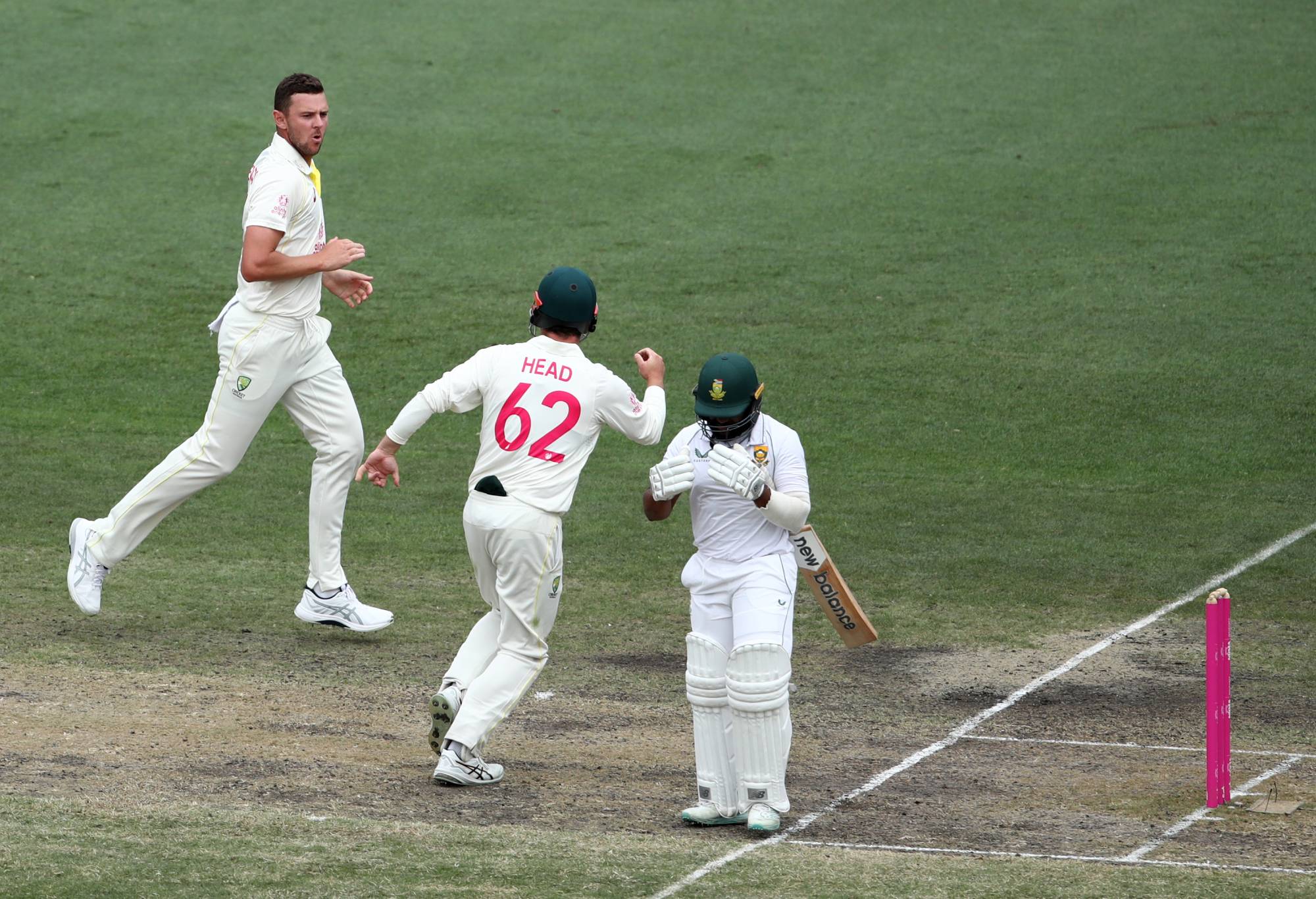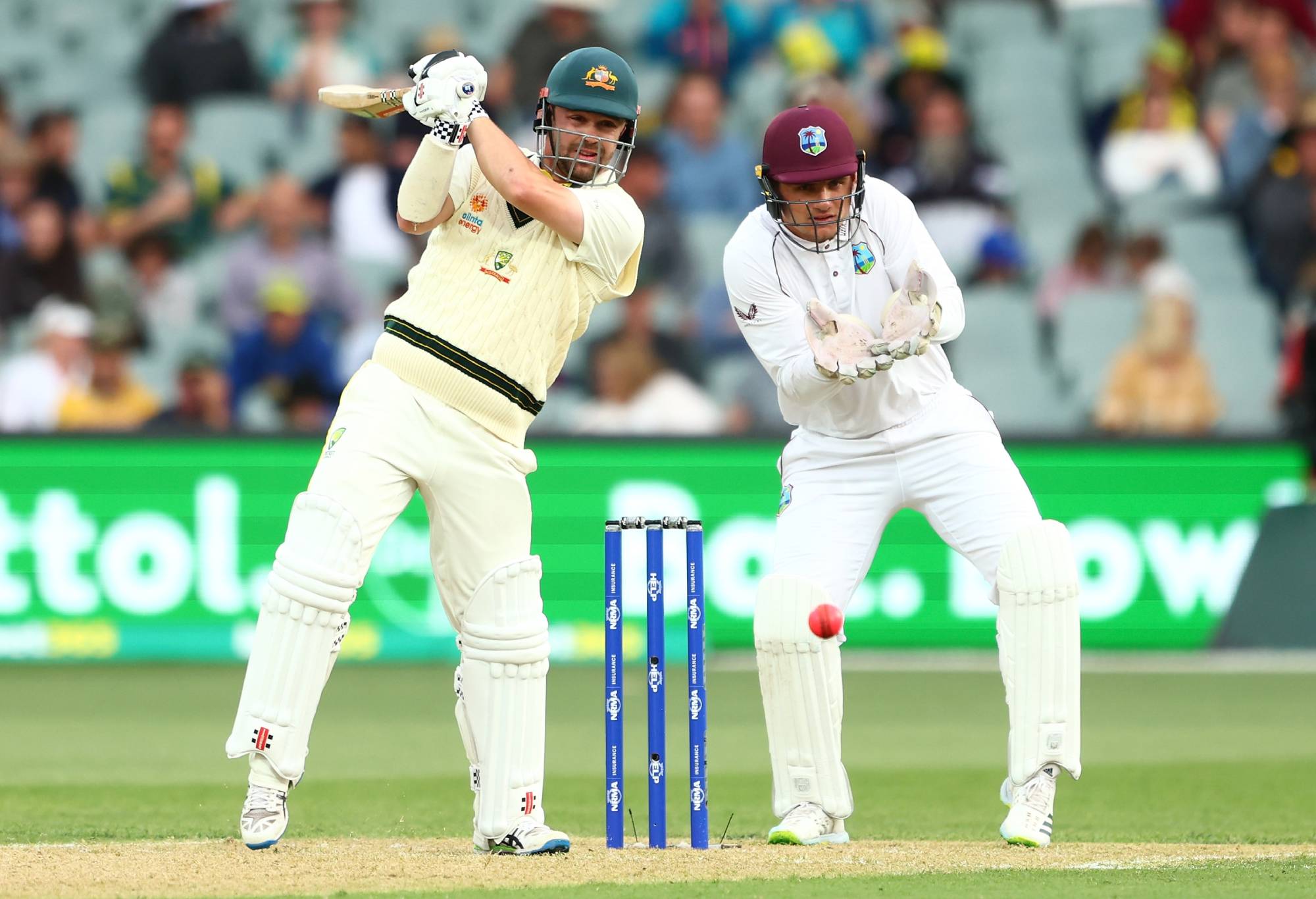South Africa and the West Indies have largely failed to be competitive in their combined five Tests against Australia this summer as the global imbalance gets worse.
Only India and perhaps England are currently set up to challenge Australia for Test supremacy with the Proteas and Windies joining the likes of New Zealand, Sri Lanka and Pakistan in an ongoing battle to remain competitive with the “Big Three” nations.
There is no easy solution for Cricket Australia when it comes to scheduling Tests at home or the ICC for that matter in trying to deliver a fair schedule.
When India and England are on tour, ticket sales and TV ratings soar but the other half of the four-yearly cycle is where the problems appear.
CLICK HERE for a seven-day free trial to watch the Big Bash League on KAYO
India are slated to play five matches in Australia in 2024-25 with England heading back the following summer.

Australia celebrate with the trophy. (Photo by Cameron Spencer/Getty Images)
As it stands, three Tests against New Zealand is all that will be on during the 2026-27 home summer before a tour of India which could get under way as early as mid-January. Then the Australians are due to return home to play Bangladesh in two Tests in March. They haven’t played a home Test that late in the season since a two-match series against Pakistan in 1979.
There are 12 Test-playing nations after Afghanistan and Ireland were elevated to cricket’s elite tier in recent years but Australia, England and India rarely play the teams at the bottom of the rankings for a variety of reasons.
Australia, for example, are scheduled to play just one Test against Afghanistan (in 2026) as part of the 2023-27 ICC program.
ICC chairman Greg Barclay during a New Zealand radio interview on the weekend that cricket was in a really fortunate position as the fastest-growing team sport in the world.
However, he said with the growth in the T20 format and women’s cricket, that traditional facets of the game like Tests need to be restructured.
“Clearly not everybody is going to be able to play Test cricket. That will be the part that we see probably compromised but the ICC are committed to continuing with Test cricket,” he told NewstalkZB, pointing to the success of the World Test Championship. “Our big challenge from a cricketing point of view is the calendar. It’s incredibly congested and getting more so all the time.
“From the ICC’s point of view, we’ve taken the view that Test cricket is an integral part of the game, it’s what makes cricket special. It’s incumbent on all of us to try and make it work.
“It’s really, really tricky to make all of this work,” he added when talking about trying to factor in three formats of varying financial success.

(Photo by Jason McCawley – CA/Cricket Australia via Getty Images)
Former Australian captain Ian Chappell theorised on Cricinfo recently that Test cricket should only be played by the eight traditional nations who have the infrastructure to cope, meaning the Afghans, Irish, Zimbabwe and Bangladesh would be excluded.
Perhaps a better solution would be to set up a promotion and relegation system between the 12 teams over the course of the three-year World Test Championship cycle – the current one ends with a final next June in England.
Whichever teams finish in the top six play each other for the next three years while the bottom six duke it out among themselves.
Then after playing against more evenly-matched opponents in the respective tiers over another three years, the last-placed nation in the top group would be relegated, replaced by the best side from the bottom six.
Chappell’s long-time sparring partner, English legend Sir Ian Botham, said there’s a case for two divisions “with promotion and relegation to make it a bit more exciting” in the Sydney Morning Herald on the weekend along with former Australian skipper Mark Taylor, who likes the idea of two divisions being “a way of trying to entice countries to want to play Test cricket in that top six”.

Pat Cummins of Australia celebrates after taking the wicket of Kyle Verreynne of South Africa. (Photo by Brett Hemmings – CA/Cricket Australia via Getty Images)
While a promotion/relegation system for Test cricket works well in theory, it would be hard to institute in reality.
The ICC currently sets the Future Tours Programme in five-year blocks, factoring in all the bilateral series across three formats for the 12 full member nations so it would be hard to rejig that on the run if teams went up or down the divisions.
And what would happen to major series such as the Ashes if England and Australia were in separate divisions? Would they be cancelled until the two nations were back in the same division or continue to be played and sit outside the world championship standings?
Despite the lopsided contests this summer, the Australian public still came out in force to support their team.
Perhaps it was due to the fact that it was the first summer since 2019-20 that wasn’t affected by pandemic restrictions, but Cricket Australia was thrilled with the crowds at the five Tests.
The opener in Perth only drew a little more than 40,000 fans across five days – that was pretty much on par with historical attendances for West Indies Tests at the WACA Ground but it was not a good look aesthetically at the much larger Optus Stadium.
Adelaide crowd figures were also up with the overall figure of 86,617 fans the highest for a match against the Windies in more than 40 years while Brisbane hosting its fixture closer to Christmas was also a winner with the Gabba attracting 29,306 and then 18,206 for what turned out to be the shortest Test in nine decades.
More than 156,000 supporters attended the four days of the MCG Test win over South Africa and there were more than 122,000 for the five days at the SCG, including just under 24,000 who turned up for the washed-out third day.

(Photo by Chris Hyde/Getty Images)
There were all sorts of theories put forward at the start of the summer about the Australian team supposedly being on the nose with the general public due to their role in coach Justin Langer’s abrupt exit last summer and the players’ views on political issues.
It turns out the poor crowds in October and November were more due to the fact that the Aussies got off to a poor start in the T20 World Cup and that the subsequent meaningless three-match ODI series against England was seen by the fans for what it was worth – not much at all.
Australia’s Test program 2023-27
2023
February-March: four Tests in India
June: World Test Championship at The Oval
June-July: Five Test Ashes tour of England
December: Three Tests at home v Pakistan
2024
January: Two Tests at home v West Indies
February-March: Two Tests in New Zealand
December-January: Five-Test Border-Gavaskar series at home v India
2025
February: Two-Test tour of Sri Lanka
June-July: Two-Test tour of the West Indies
December-January: Five-Test Ashes series against England
2026
August: One Test at home v Afghanistan in northern Australia
September-October: Three-Test tour of South Africa
December-January: Three Tests at home v New Zealand
2027
January-February: Five-Test Border-Gavaskar Series tour of India
March: Two Tests v Bangladesh at home
>Cricket News

%20(3).jpeg)



0 Comments